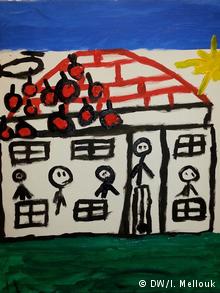31 Aug 2015
The Syrian refugee children suffering from the effects of war and the cruelty of life, which may expose them to psychological disorders aggravated with the passage of time, if not treated. Artist Hassan Hussein Davigi help these young refugees through a project for treatment by drawing.
In “Deutz” neighbourhood on the right bank of the Rhine River in Cologne there is a modest atelier for the visual artist Hassan Hussein Davigi. On the walls there are many of paintings which show different tales reflect the full sense of the artist who allocate his art in humanitarian issues. Here the artist hosting Syrian refugee children participating in the project of psychological treatment by art.
Hassan Hussein Davigi, 42, a Kurdish artist and art therapist. He had to leave Turkey 20 years ago because of his political activity, to settle later as a refugee in Germany. He says “Like any refugees in the beginning I faced many difficulties, but I decided achieve my goals and have already succeeded in doing this”, he added “I believe that happiness lies in helping others achieve their goals and that is what I seek through my project”.
The project, which Davigi called “My story by colour” launched since September 2014 under a cooperation agreement between the German Red Cross and the artist Davigi. At first the artist was visit the children and their families in shelters and refugee centres and offer to them his services which he offered it as a volunteer, as he said.
Davigi hopes his project have financial support in the future and to receive the attention. He says that this type of treatment is useful for the children of refugees, who suffer from mental disorders because of the events of the war.
And about his way of painting therapy, the artist explains “Treatment by drawing depends in three phases. In the first stage, a stage of discharging given to the person the possibility of output what is inside through a drawing. And then comes the second stage is the stage of the analysis, which is the most important stage in treatment, where the therapist get to know the patient in indirect way, so therapist can read through the drawing to identify the pressures and psychological problems, suffered by the patient. This information helps the therapist later in the final stage of treatment, which is done by drawing too”.
And to identify the extent of the effectiveness of this kind of treatment from a scientific point, Bgiqith Msheels, psychiatrist and competent in Art Therapy, saying to Deutsche Welle Arab: “drawing therapy is a type of Art Therapy and may have effective results in cases of mental disorders and depression.”
She adds “through the process of dropping the photos on the paper, person can discharge negative energy inside and express a feel in the subconscious without the need to use the language”. Msheels also confirm that this discharge process may lead to changes in behaviour, and in many cases the treatment may not take a long time to get the results.
On the other hand, parents express their impressions about the participation of their children in painting project. Ali, the father of Afjen and Warren, says that this project has helped his children very much, where the children were able to get rid of their sufferings and think in more bright thoughts.
And Hassan shared his opinion, the father of Yasmen, saying, “My children are always excited to come to the atelier, their psychology has improved a lot than ever before, their grades were good the they did not suffered from the problems in their schools”.
When asked about the extent of the development, and children’s response to treatment through their drawings, the artist Davigi says that “since the beginning of the project so far the scenes of war and destruction still repeated in the children’s drawings, even if they apparently do not feel any psychological problems.” In his view, this transformation and development needs longer time to appear in the drawings.

 عربي
عربي
